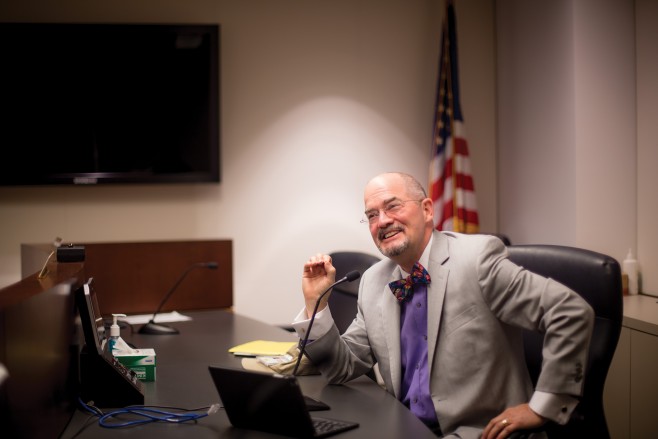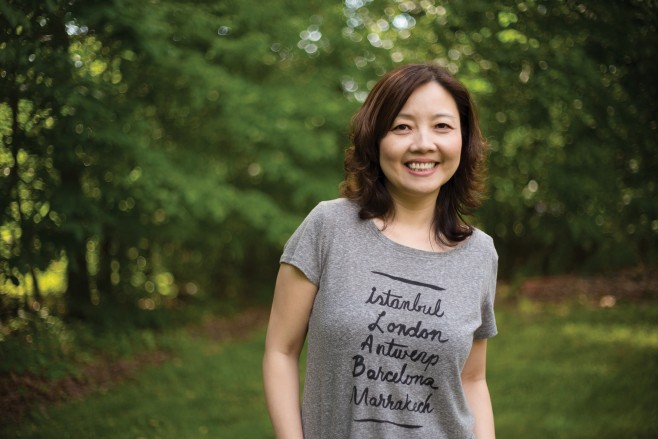
David Bucher ’74, who has a law degree from George Washington University, is an administrative trademark judge on the U.S. Trademark Trial and Appeal Board. (Photo by Jon Styer)
If you saw the word “Jin-Ja,” what would come to mind? What if you saw it on a label featuring the spiky red flower of Zingiber officinale? Or what if you spoke a non-rhotic dialect of English, meaning you’d pronounce “Jin-Ja” more or less the same as you would “ginger”? And does any of this affect whether the maker of a gingery beverage called Jin-Ja should be allowed to register the term as a trademark? Such were the questions recently pondered by David Bucher ’74 and two other administrative trademark judges on the U.S. Trademark Trial and Appeal Board (TTAB).
On initial review, the United States Patent and Trademark Office (USPTO) said no. But after the maker of Jin-Ja appealed, the matter ended up on Bucher’s docket.
Though Bucher agreed with the original ruling, the two other judges on the panel did not. Case closed. Jin-Ja is now a registered trademark, and Bucher was left to write his dissenting opinion. Although most of his written opinions are unanimous (the 19 TTAB judges are randomly assigned to hear cases in groups of three), Bucher finds dissents and concurrences – where he agrees with the majority ruling, but for different reasons – the most fun. That’s because he’s the only writer and doesn’t need sign-offs from other judges on the “creative bons mots” (as he puts it) that he tries to write into his legal opinions.
This isn’t the kind of legal material that often makes the headlines or the movies. There’s not a lot of high drama. And from the outside, the issues can just seem silly (see, for example, Bucher’s 2009 dissent in In re Chippendales USA, Inc., where he argued that the bowtie and cuffs worn by Chippendales’ male strippers deserved trademark protection).
At the same time, intellectual property protection is a key underpinning of our entire economic system. The shelves at a typical supermarket, Bucher says, are lined with about 40,000 different trademarks. And the TTAB does make the occasional cultural splash, as it did in 1999 and again in June 2014, when it cancelled some of the Washington Redskins’ trademark registrations on grounds that the name of the city’s NFL franchise is disparaging to Native Americans. (Bucher was not on either of the panels that issued those decisions.)
“That’s one of those things where there’s a pretty strong connection between what seems to be an arcane area of law and an everyday issue that this metropolitan area continues to struggle with,” he says.
Bucher has been with the USPTO since the early ’80s. After majoring in business at EMU, he earned a law degree from George Washington University and took a Peace Corps assignment in Barbados (“tough duty, but someone’s got to do it”). Afterwards, at a time when jobs for attorneys were scarce in the Washington D.C. area, a friend of a friend pointed him toward an opportunity at the USPTO. Though he’d never taken an intellectual property class in law school, he gave it a shot.
“I just kind of fell into the job and developed a passion for trademark law,” he says.
Bucher began as an examining attorney tasked with reviewing up to 2,000 trademark applications per year. That’s about one application review per hour: searching the ever-growing database of previous registrations, ensuring the application met various statutory and technical criteria, and making a decision on whether the applicant should or shouldn’t be granted exclusive use of the particular word or mark. (One of the thousands of trademark applications that crossed his desk was for O.J. Simpson’s signature, back when Simpson was just a retired football star.)
By 1987, Bucher had been promoted to executive director of the trademark examining operation. Over the next dozen years, he oversaw the agency as it grew from 100 to 400 attorneys. He also helped put in place its first telework program. He was appointed to the TTAB in 1999. Its judges don’t break down along the same conservative-liberal line that divides the Supreme Court, but they do have their own proclivities.
“I’m one who chafes if a decision ends up being made in some sort of technical form over substance,” says Bucher, who doesn’t like seeing someone score a big windfall on a technicality. “I guess I’m more on the big-picture side.”
The “P” in USPTO stands for Patents, an entirely different branch of intellectual property where Jenny Wu ’92 has spent the past four years as a patent examiner. Unlike trademark examiners – generalists concerned with the meanings conveyed by words and symbols – a patent examiner needs specialized expertise in particular fields.

Jenny Wu ’92, majored in chemistry at EMU, and then spent years as a developer for a company that designed software for simulations of chemical processing, before shifting to the federal government where she evaluates patents for alloys and alloy production processes. (Photo by Kara Lofton)
Wu works in Technology Center 1733, which handles patent applications related to metallurgy. Lately, she’s been spending a lot of time evaluating patents for alloys and alloy production processes used by the auto industry.
Examiners like her also have quotas to meet. Every two weeks Wu has to process at least four new applications and four amendments. Each one requires careful reading of the application to fully understand the what, why and how of the New Thing the applicant wants to patent. Then she’ll begin comparing the New Thing to every other similar thing that already exists and decide whether the New Thing does or doesn’t merit patent protection.
“It’s never boring or dull. Every case is different,” says Wu, who works from her home near Richmond, Virginia. “Every applicant is an inventor, and I feel like I have the responsibility not to discourage these inventors for applying for patents. I try to encourage that atmosphere of innovation.”
Wu majored in chemistry at EMU, and then spent years as a developer for a company that designed software for simulations of chemical processing. The move to the patent office was a way “to go back to chemistry instead of doing computer stuff.” For a while she was reviewing chemical coatings, then shifted over to batteries (the rise of electric cars have sparked a scramble in the industry to stake out intellectual property claims) before moving on to metallurgy. Innovation continues fast and furious, and applications have piled up in a two-year backlog. There’s plenty more metallurgy to keep her occupied.
Given the complexity of navigating the federal government’s intellectual property apparatus – and the disputes that inevitably arise over intellectual property after registration – it is surrounded by a sea of lawyers.
Some, like Peter Kraybill ’97, help people navigate the complex process of filing patent or trademark applications. In 2014, Kraybill filed more than 60 trademarks. (For a story about his firm, see page 46.)
Others litigate intellectual property disputes. If Company A thinks its patent or trademark is being infringed by Company B, A can “assert” its patent against B in court (a regular civil court, distinct from Bucher’s administrative court, which only deals with disputes related to trademark registration itself).
“I like the chance to think creatively about how to rebut arguments made by the other side,” says Eric Rutt ’01, who specializes in intellectual property litigation as an associate with Wolf Greenfield in Boston. He enjoys the “chess match” aspect of arguing a case in court: “You have a very concrete challenge before you. It’s very, very clear what counts as a win and a loss.”
Rutt recently represented, for example, a defendant accused of infringing another company’s software patent. The case involved the most complex series of briefs he’d ever seen.
“In the thick of it, it was a little exhausting, but that’s where you get the most interesting work and where you grow the most as well,” says Rutt.
The case was dismissed through summary judgment. Mark one in the win column for Rutt and his client.
Another recent dispute over the functioning of an adjustable bed got a little more complicated. Rutt’s firm got the infringement claims against his client dismissed (win), and then proceeded to win a jury trial on a breach-of-contract counter-suit his client leveled against the other maker of adjustable beds (double-win).
Pulling it off required Rutt to “translate the issue into simple concepts for a jury, and present a compelling moral story to make the jury care,” Rutt wrote in an email to Crossroads.
The gray areas in patent law are huge. In a typical infringement case where he’s representing a patent owner, Rutt has to argue that the patent is wide enough to cover the product that’s accused of infringement but narrow enough that it’s distinct from previously existing technology, as required to obtain a patent in the first place.
“This requires that patent lawyers be able to find distinctions that allow them to simultaneously argue for broad and narrow interpretations of the patent,” he continued.
Rutt credited former professors at EMU – in particular Glenn Kauffman, class of ’60, (teaching chemistry) and Bill Hawk, MDiv ’74, (philosophy) – with laying “the foundations for flexible thinking by encouraging students to look at an issue from many angles.”
“I don’t remember 99% of the details that I learned in my chemistry and philosophy classes,” he wrote. “But the modes of thinking have stayed with me and I use them regularly in the practice of law.”